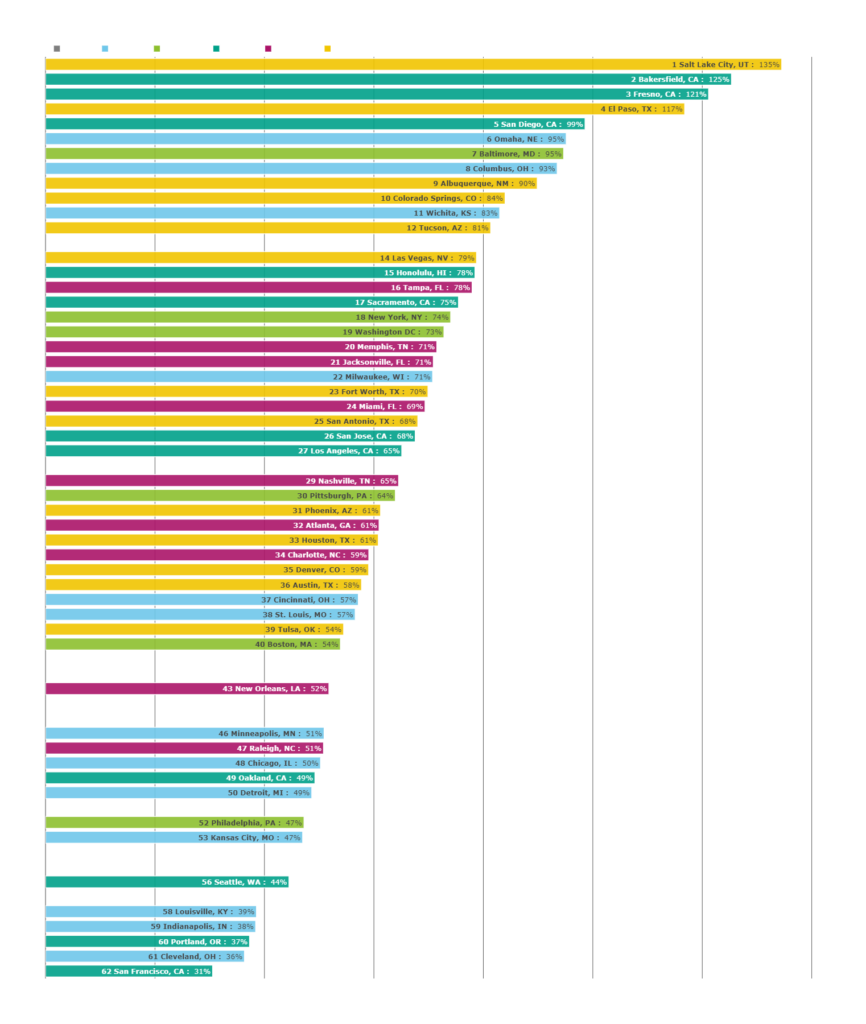Data show that Downtown Minneapolis has had the worst recovery of daytime and weekday activity in the United States
Back in April 2023, I started tracking data from the University of Toronto’s School of Cities which was “looking at cell phone activity at points of interest (POI) in the downtowns of the top 62 cities in North America and comparing the most recent period to pre-pandemic spring 2019 to assess the recovery of these downtowns from COVID-19.” I wrote:
Figure 1 shows how activity in the cities in the United States has recovered from COVID-19 by Fall 2022. Only four are above their pre-pandemic levels: El Paso, Fresno, Bakersfield, and Salt Lake City. Omaha is the best performing city in the Midwest, having recovered 95% of its activity.
But where is Minneapolis? It is towards the bottom of the ranking, having recovered just 51% of its pre-pandemic activity, only slightly better than Chicago and Detroit.
Figure 1: Recovery of downtown to Fall 2022

Minneapolis is in a bad way and that is bad for our state. How can we turn it around?
Of course, the Babbitts in Minnesota’s media could not let this slight on their largest city go unanswered. In November 2023, WCCO reported on this data but included a lot of chin scratching about its methodology, far more than it engages in when far more questionable “studies” paint a favorable picture.
In April 2024, it was Kare 11’s turn with a story titled “From Taylor Swift to the Timberwolves, events propel downtown Minneapolis to top of recent recovery rankings.” Using a different data set from the University of Toronto’s School of Cities — Recovery Trends rather than the Recovery Rankings I had looked at previously — they reported that:
…cell phone data from March 2023 to March of 2024, found that downtown Minneapolis topped the list. Visits grew by 45%, which was ten percent more than Chicago, the next closest U.S. City.
…
The comeback in Minneapolis continued through much of July thanks – in part – to other big events like the Taste of Minnesota Festival and Minneapolis Aquatennial…
Kare 11 noted that this was, in part, because Minneapolis “started on a low note. The previous update from 2023, found that Minneapolis ranked near the very bottom of the recovery rankings.” A more recent look, from April 2023 to April 2024, shows Minneapolis back down to 15th spot.
And there is further cause for concern:
If you look closer at other data provided by the School of Cities, you begin to see what’s been holding the city back. While night and weekend traffic is back near pre-pandemic levels, visits during weekday working hours are still less than half of what they were.
Indeed, the University of Toronto’s School of Cities Recovery After Hours data set show that, while Downtown Minneapolis has recovered more than 80% of its 2019 level of activity outside of working hours, it has recovered just 44% of its 2019 level of activity during working hours, the lowest level out of all 66 cities included in the data. Minneapolis has also only recovered about 50% of its 2019 level of activity on weekdays, again, the lowest level out of all 66 cities included in the data. As a place to play, Downtown Minneapolis is doing ok. As a place to work, it is dying. On this measure, we are below Chicago and Detroit.
This ties in with something else I have written about before. Kare 11 notes:
Cell phone trends aren’t the only thing driving the urgency for downtown reinvention, according to the latest real estate data, more than 30% of downtown offices remain vacant. That is already having an impact on property values that impact the tax base for the city, county and the entire state.
In an article on the same theme, the Star Tribune notes that “The value of downtown’s commercial buildings — a key contributor to the city’s tax base — has fallen 13% since last year, according to the city assessor’s office.” The death of Downtown Minneapolis as a workplace is setting the city up for some tough budget decisions.